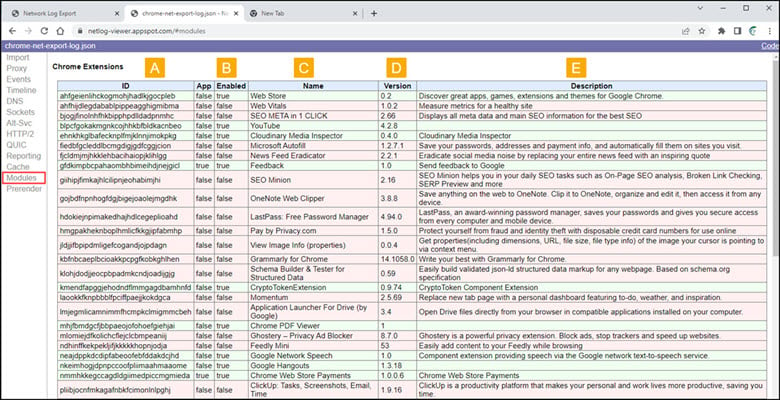Many times when troubleshooting browser issues you need to find out all the extensions. This can be a time-consuming process. In this tutorial, I’ll show you how to find all your browser extensions using net-export. The nice thing about this tool is it also shows the extension ID which is the folder name.
The Initial Problem
Sometime back, I wrote an article on how to remove Chrome extensions that included deleting the extension’s folder if the normal uninstall methods didn’t work. The problem was it required people to systematically step through the folder names and open the JSON file to find the offending extension. If you had a lot of extensions, this could take a while since the folder names are cryptic.
If you’re comfortable capturing a network log file, there is a more efficient method that works with Chromium-based browsers.
Capture a Network Log
For these steps, we’ll be using a network capture tool. Since the tool captures more than your browser’s extensions, it’s best to have as few browser tabs open.
- Open your browser.
- In your browser’s address bar type chrome://net-export/ for Chrome or edge://net-export/ for Microsoft Edge.
- A Capture Network Log page will appear. Keep the default settings.

- Click the Start Logging to Disk button at the page top.
- The Save As dialog will open.
- Click Save to keep the default name chrome-net-export-log.json.
- Open a new browser tab.
- Go back to the Network Log export tab.
- Click the Stop Logging button.
- Click the netlog viewer link above the privacy heading.
- Click the Choose file button and select your file.
- Click Modules from the left menu.
The Modules Extension Table
When you click Modules, you’ll be greeted with a color-coded table that shows your browser’s extensions. This list will include extensions you installed as well as some native ones you can’t uninstall.

[A] ID– The cryptic string of letters and numbers that is the same name as the extensions folder name.
[B] Enabled – this column indicates if the extension is enabled or not. Items that are enabled show in a green band.
[C] Name – the extension’s name
[D] Version – the version number for the extension.
[E] Description – a short description of the extension
Finding the Main Extension Folder
Once you have the modules table, you can go about finding the main folder. The location varies based on your operating system and which Chromium browser you’re using. You also need to substitute your user name.
For Google Chrome on Windows 10
C:\Users\user name\AppData\Local\Google\Chrome\User Data\Default\Extensions\For Microsoft Edge on Windows 10
C:\Users\user name\AppData\Local\Microsoft\Edge\User Data\Default\ExtensionsWhen you drill down into your main folder, you’ll see a series of additional folders. Each one represents one of your extensions. For example, if I wanted to find my Momentum extension folder, I would grab the ID from the modules table and look for a folder with the name laookkfknpbbblfpciffpaejjkokdgca.

Hidden Extensions with No Folders
If you’re like most people, you looked at the extension descriptions and didn’t recall using the CryptoToken Extension. The next thought was whether your PC was hacked and if someone was using it to mine Bitcoin. And chances are you became more concerned when you could not find the kmendfapggjehodndflmmgagdbamhnfd folder.
This CryptoToken Extension is in fact hidden, but it’s part of Chromium. It’s used by some well-known sites for hardware authentication purposes. There is a good explanation on the Vivaldi browser community forum. Vivaldi is also a Chromium-based browser.
And if you add up the number of extension folders on your computer and compare that to the number of items on the modules list, you probably have a difference. Some other extensions without folders on my system include:
| Extension ID | Name |
| ahfgeienlihckogmohjhadlkjgocpleb | Chrome Web store |
| gfdkimpbcpahaombhbimeihdjnejgicl | Google Feedback |
| kmendfapggjehodndflmmgagdbamhnfd | CryptoToken Extension |
| mhjfbmdgcfjbbpaeojofohoefgiehjai | Chrome PDF viewer |
| neajdppkdcdipfabeoofebfddakdcjhd | Google Network Speech |
| nkeimhogjdpnpccoofpliimaahmaaome | Google Hangouts |
| nmmhkkegccagdldgiimedpiccmgmieda | Chrome Web Store Payments |
While the above list is from my instance of Google Chrome, other Chromium browsers have hidden ones too. In fact, you’ll find the same CryptoToken Extension for Microsoft Edge with the same folder name as well as others.
